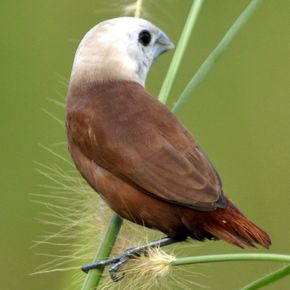“Lining the newly-redeveloped Bishan Park river are fields of grasses and weedy plants growing naturally. The lush and undisturbed vegetation has become home to an assortment of birds, in particular finches. To be more specific, the birds mentioned here are of the Families Passeridae (Subfamilies: Passerinae, Ploceinae and Estrildinae) and Fringillidae. These seed-eating grassland birds are most likely attracted to the plethora of seeds available for them to feed on. Moreover, as the park has not been officially opened, the level of human activity is still minimal, thus allowing the birds to flourish.
“Scaly-breasted Munias (Lonchura punctulata) are abundant here. Flocks feed on grass seeds, even perching on small trees nearby (above). Juveniles can be seen and heard clamouring for their parents’ attention as the adults bring food back to the family. Amongst the flocks of Scaly-breasted Munias (below left) are the occasional White-headed Munia (L. maja) (below centre) and Black-headed Munia (L. malacca) (below right). These two species are less-commonly encountered in urban Singapore and their presence at Bishan Park is certainly good news.
“The ubiquitous Eurasian Tree Sparrow (Passer montanus) is present closer to the paths that people frequent and of course at the new McDonald’s. Perhaps their numbers will rise rapidly after the park is opened and people start leaving crumbs and litter behind.
“We have also recorded a few escapees – Old World seed-eaters that have been previously mentioned in BESG: LINK. These brightly-coloured exotics will surely attract more attention and curiosity from park users than the more drab munias.
“A Yellow-fronted Canary (Serinus mozambicus) was heard singing merrily from its perch on an overhanging tree branch on 9th May 2011 (below left). Despite the poor photograph, it can be identified from the black malar stripe. You can also see that this male appears to have a growth of sorts on his right eye.
“Shanny’s contact Wi Ming sent her a photograph of a male Zanzibar Red Bishop (Euplectes nigroventris) in full breeding plumage (above centre). It is characterised by the black on the underside extending from throat to belly. We then saw him for ourselves foraging on the ground and in the grass on 19 May 2011. On 4th July 2011 two Orange-cheeked Waxbills (Estrilda melpoda) (above right) were seen with a flock of Scaly-breasted Munias also feeding on grass seeds.
“It will be interesting to see if more species appear here. This urban and easily accessible grassland could well be a new spot for photographers!”
Photo Credits:
1. Scaly-breasted Munia Tree – taken at Bishan Park by Serene Chng. Lots going on here – at the top of the photo a parent feeds a young bird, other individuals indulging in preening and comfort behaviour. Many Estrildid finches are known to be gregarious and breed socially, but I wonder if any cooperative breeding takes place, i.e. do other individuals apart from the parents help to care for the young?
2. Scaly-breasted Munia – taken at Pangsua Park Connector by Sek Jun-Yan
3. White-headed and Black-headed Munias by Dato’ Dr Amar-Singh HSS
4. Yellow-fronted Canary – record shot taken at Bishan Park by Serene Chng.
5. Zanzibar Red Bishop – record shot taken at Bishan Park by Wi Ming.
6. Orange-cheeked Waxbill – record shot taken at Bishan Park by Serene Chng.
Serene Chng and Shanny Tan
Singapore
11th July 2011


![MuniaSB-tree [Serene Chng]](https://besgroup.org/wp-content/uploads/MuniaSB-tree-Serene-Chng.jpg)
![MuniaSB [SekJunYan]](https://besgroup.org/wp-content/uploads/MuniaSB-SekJunYan.jpg)

![MuniaBlHd-grass [AmarSingh] - 2](https://besgroup.org/wp-content/uploads/MuniaBlHd-grass-AmarSingh-2.jpg)
![CanaryYF [SereneChng]](https://besgroup.org/wp-content/uploads/CanaryYF-SereneChng.jpg)
![BishopZR [WiMing]](https://besgroup.org/wp-content/uploads/BishopZR-WiMing.jpg)
![WaxbillOC [Serene Chng]](https://besgroup.org/wp-content/uploads/WaxbillOC-Serene-Chng.jpg)







6 Responses
Looks like we have lots of other foreign talent
I have seen Little Egrets in the channel sometime ago before the present upgrading work commenced. Recently I encountered a Collared Kingfisher in a tree along a footpath leading from Sin Ming Walk to the Park.
On Tuesday, I was surprised to see 3 White-headed Munias, “hopping” amongst the grass on a slope. It was during the morning rush hour, nearby a hospital ground in the southern part of Singapore.
Hi Chong Hong,
There’s quite a few interesting birds along the newly-developed river. We’ve been seeing at least two Purple Herons regularly and spotted a Stork-billed Kingfisher at the side nearer Lower Peirce.
Hi Ei Leen,
I think I’ve seen those too! So far when I see White-headeds they are only a few individuals in a larger flock of Scaly-breasted Munias.
Can you guys help to identify this “Munia/Waxbill” of Yellow Head with lower (bottom)part and bill area in black. But the chest and tails are yellow. Wings are strips of yellow and black found at Punggol Barat (Seletar North Link Rd.) Unfortunately this site couldn’t leave any photo otherwise I could leave a copy.
Appreciates your time.
David N Chai.